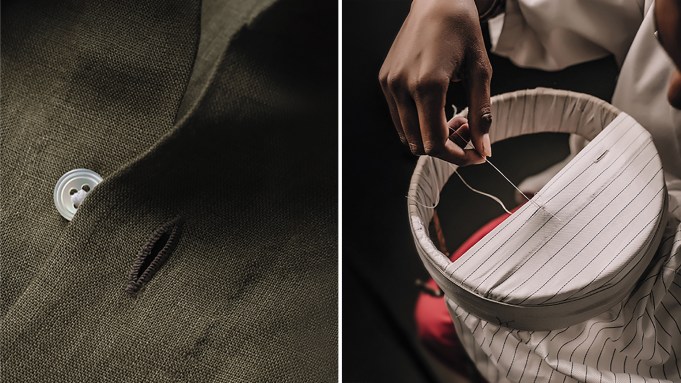How far would you travel to watch your next bespoke shirt being made?
Some craft-conscious customers will hop over to to visit or . Others fly to Naples to observe and other Italian makers in action. But a select group, it turns out, will journey as far as Amritsar, a city in northwestern , near the country’s border with Pakistan.
“We get a lot of customers, actually. They like to come and see us,” says Varvara Jain, cofounder of , the company she established with her husband, Akshat, in 2014. The couple previously worked in investment banking, but when Akshat began to crave a change from the corporate grind, he offered to take over a small shirt-making workshop his family owned in Amritsar where six workers made clothes for friends and relatives. With Varvara’s support—she leads sales and marketing—Akshat has transformed the company’s shirts into a staple for tailoring cognoscenti, with an international reputation for quality and a staff that now runs to 385 members.
The only thing we care about is quality. That’s been our mantra from day one.
The Jains are at the forefront of a new movement in luxury that positions clothes made in India on par with similar wares crafted in France, Italy, England, and the U.S. Despite the negative headlines generated by the region’s fast-fashion industry, India has a rich history in the apparel trade, replete with fabric weaving, intricate embroidery, and hand-sewing. High-profile European designers including Gucci, Saint Laurent, and Dior have quietly relied on Indian craftspeople to produce some of their most complicated designs for decades. Today’s bright young things are much more open about doing the same: , the award-winning New York–based brand founded in 2016, is known for the patchwork jackets and embroidered pieces it makes in New Delhi. , a U.K. operation started in 2020, is heralded not only for its commitment to sustainability but also for the complex bandhani (tie-dye) and arjak (block printing)—both centuries-old Indian crafts—that give its airy shirts and trousers a distinct look.
We’re focused on making things in the best place that we can get it made,” says Peter Middleton, whose New York City–based label produces many of its updated takes on vintage Americana in India. “Not as in the country, but as in a specific mill or a specific factory. If that factory happens to be in Chennai, that’s OK.”
Whitcomb & Shaftesbury’s Chennai workshop employs 28 tailors, each trained by Savile Row veterans.
Harshan Thomson
But for every or (Western brands that contract with Indian facilities), there are now independent operations going one better. Like 100Hands, these companies have established purpose-built workshops to make shirts, suits, and shoes under their own labels and are setting new standards for ethical employment and manufacturing as they go.
“The ambition was always to make the finest shirts,” says Jain, dialing in from Amsterdam, where she and her husband met. That meant crafting made-to-measure and bespoke examples exclusively by hand, which is what led to the brand’s name: Fifty skilled individuals are involved with the production of every shirt. Customers can buy its ready-to-wear at 145 stockists across the globe, including in New York City, starting around $300. The custom versions, which require getting measured at one of the company’s biannual trunk shows in New York or at a participating retailer, are available in two grades of manufacturing: Black Line and Gold Line.
“In both cases, we hand-draw the patterns and hand-cut [fabric] individually,” Jain says. “In the Black Line, we hand-sew the fronts, the collar attachment, gussets, and the sleeves. In the Gold Line, we [hand-] sew everything that we think is beautiful to show.” Which effectively means that nearly everything is done by hand and the quality of stitching is so fine you can struggle to see it without a magnifying glass. Black Line shirts start at $345 and require around 16 hours to produce, while a Gold Line shirt—yours for $495 or more—benefits from up to 36 hours of handwork. (The esteemed Parisian shirtmaker , by comparison, offers ready-to-wear shirts from around $495, and its custom jobs can cost more than $600.)

SMR Days, a London-based brand, is known for using Indian printed fabrics.
Courtesy of SMR Days
In addition to quality, 100Hands is also committed to retaining staff. Rather than being paid per piece—which is common in Indian clothing manufacturing and incentivizes speed over quality—employees are salaried. Pensions are provided for all staff, and health-care coverage extends to their immediate families. Clearly, it works: The business has developed so robustly that the couple have started to build another factory.
Some of India’s luxury-menswear operations have taken a longer route to competing on a global scale. In the case of , a bespoke tailor with workrooms in London and Chennai, it’s understandable. Brothers Suresh and Mahesh Ramakrishnan had just established the brand’s presence in England when the 2004 Indian Ocean tsunami swept across large parts of Southeast Asia, at which point they saw an opportunity to do some good by producing garments in their homeland. They approached the charity , which was serving people who’d been affected by the disaster and teaching them new craft skills. “One of the things we thought about was, rather than build a business and write a check for charity, why couldn’t we actually make that part of our business?” Suresh says.
The pair set up a workshop in Chennai, a city on India’s southeast coast, and dispatched London tailors to teach the new hires. The plan wasn’t without its challenges. “It took a long time to get to the point where we were really happy with the quality,” Suresh notes.

The pieces of many Whitcomb & Shaftesbury bespoke suits are cut in London then sewn in India.
Courtesy of Whitcomb & Shaftesbury
Yet after four years of training their Indian team and getting the product just right, the brothers made the Chennai workshop the production facility for the company’s Classic Bespoke garments, whose component parts are cut by hand in Mayfair and sent east to be sewn. Prices for a two-piece suit start at $4,100. (For clients who want everything made in London, it also offers what it calls a Savile Row Bespoke alternative that starts at $6,500, even though the brand is not located on tailoring’s most famous street. For comparison, the suits from ’s highest-level bespoke service can cost around $8,000.) As with 100Hands, Whitcomb’s handmade tailoring is impressive—and, like the shirtmaker, the recipient of a Robb Report Best of the Best award.
The Ramakrishnans attribute their success to a sort of workroom buddy system. Of Whitcomb’s 28 tailors in India, around half are now experienced master tailors who each supervise one or two apprentices, which encourages staff to pass on knowledge. It also helps to ensure maximum consistency for clients, who can place orders in London or get measured during one of the team’s regular trips to New York, Boston, and Beverly Hills.

Thanks to placement in menswear tastemaker the Armoury and biannual trunk shows in New York, 100Hands has become a favorite of the cognoscenti.
Jonathan Daniel Pryce
“We have complete control over quality and our method,” says Mahesh. “We always try and keep the same coat-maker for the same customer—if the customer’s happy with the coat, we always try and keep that.”
To keep the staff happy and focused on the highest level of craftsmanship, the company offers salaries, as well as health care and similar benefits to those of 100Hands. “If we pay a piece rate, subconsciously, staff are motivated to produce more, and quality takes a back seat,” Mahesh says. “The only thing we care about is quality. That’s been our mantra from day one.”
India’s up-and-coming luxury brands can dress you from head to toe. Founded in 2011, is the brainchild of the late manufacturer Hasan Kolandaiveedu and Japanese bespoke shoemaker Jose Maria Watanabe. Today, the company’s Chennai factory employs 50 people and is run by Hasan’s son, Affan, who joined the company in 2015 with a degree from the London School of Economics. As per his father’s wishes, Affan started on the factory floor and learned the business from the ground up; he now oversees the annual production of around 10,000 pairs of Goodyear-welted shoes designed by Watanabe. The goal is to create footwear that can stand up to its English or American counterparts. To that end, the brand uses European shoemaking techniques and leathers from artisanal tanneries such as , a supplier to , , and .

Bridlen’s made-to-order shoes are designed by the highly regarded Japanese cordwainer Jose Maria Watanabe.
D. Jerald
Kolandaiveedu’s environmental-studies focus has come in handy for increasing the business’s efficiency and eco-friendliness. “I started a project early on to make us a close-to-zero-waste factory,” he says. Now, 93 percent of Bridlen’s raw materials is either recycled or repurposed, and the factory doesn’t create any chemical waste. “I was able to call up the right people to make sure that these products had a proper end-of-life disposal system,” Kolandaiveedu adds.
What Bridlen has achieved in a relatively short period is impressive. Its made-to-order goods, which are sold online directly to consumers, borrow from the aesthetic and construction of true bespoke shoes. Take the , an experimental collection that enables Kolandaiveedu and Watanabe to test fresh designs and manufacturing techniques while encouraging their craftspeople to learn new methods.
Their business model allows for the flexibility to do just that, at the same time keeping prices relatively low. Whereas a Western heritage brand such as or might charge around $1,000 for a pair of oxfords, many of Bridlen’s wares come in around $300.

Bridlen’s whole-cut oxfords and other made-to-order styles emulate the look and technique of bespoke shoemaking.
Courtesy of Bridlen
“Mr. Watanabe kept reminding me, ‘Don’t expect to be in 10 years—it took them 200 years to get there,’ ” Kolandaiveedu recalls. His goal is simply to be compared to Western labels as an equal. “If that takes us another 20 years, I’ll enjoy every day getting us there.”
Set against the full landscape of India’s clothing output, these brands are just dots on the map, but they reinforce a valuable lesson. “Don’t paint a whole country with one brushstroke,” says Suresh Ramakrishnan of Whitcomb & Shaftesbury. “There will always be pockets of excellence.”
For centuries, the fashion industry has relied on “Made in Italy” or “Made in England” labels to imply a garment’s superiority, as though only Italians can produce good shoes or Brits can tailor fine suits. In a globalized society, it’s an entirely reductive view of luxury menswear.
“People said the same thing about Italian wine,” Suresh notes. “They pooh-poohed that and then did the same thing with Californian wine until it won the blind tasting Judgment of Paris—it took a blind tasting to open people’s eyes.” Fortunately, you can see just how good India’s burgeoning menswear is with your eyes wide open.




